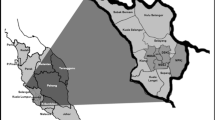Abstract
Environmental planning legislation in New South Wales now requires local government authorities to draw up statutory plans that take into account, among other concerns, both the biophysical and the social environmental issues within their jurisdictions. The SIRO-PLAN method of plan production provides a systematic mechanism for fulfilling this requirement. This article describes the application of the method by planning researchers over 18 months to the production of a Local Environmental Plan for a rural local government in New South Wales. The policy formulation, the purposive data collection, and the deliberate adjustment of plans in order to recognize interest group requirements were all found to be valuable features of the method, while the translation of the ultimately chosen land-use plan into the explicit regulatory controls available to the local government authority was found to require further refinement. The capacity of SIRO-PLAN to quantify the resolution of competing environmental concerns in the final plan, although of value to planning researchers, proved too arcane for traditionally trained planners.
Similar content being viewed by others
Literature cited
Bell, J., T. Soutberg, and P. Compagnoni. 1984. Data collected to evaluate Yarrowlumla Shire environment use strategies. CSIRO division of water and land resources technical memorandum 84/9, Canberra.
Bishop, I. D., and J. G. Fabos. 1981. Application of the CSIRO land use planning method to the Geelong Region. CSIRO division of land use research divisional report 81/3.
Christian, C. S., and G. A. Stewart. 1968. Methodology of integrated surveys. Pages 233–280in Aerial surveys and integrated studies. Proceedings, Toulouse conference, 1964. Unesco, Paris.
Cocks, K. D. 1984. Application of a systematic method of public use zoning to the Great Barrier Reef Marine Park, Australia.Coastal Zone Management Journal 12:359–383.
Cocks, K. D., J. R. Ive, J. R. Davis, and I. A. Baird. 1983.Siro-plan andLuplan: an Australian approach to land-use planning. 1. TheSiro-plan land-use planning method.Environment and Planning [B]10:331–345.
Davis, J. R. 1981. Weighting and reweighting insiro-plan. CSIRO division of water and land resources technical memorandum 81/2, Canberra.
Davis, J. R. 1984. A systematic approach to data collection for planning.Journal of Environmental Management 19:119–131.
Davis, J. R., K. D. Cocks, and J. R. Ive (1984)Siro-plan: improving the acceptability of a practical planning method.Planning Outlook (in press).
Davis, J. R., and J. R. Ive (1985). An application ofsiro-plan to local environmental planning. CSIRO division of water and land resources divisional report 85/2, Canberra.
Davis, J. R., and P. A. Walker. 1980. The use of computers in Australian local government.Urban Systems 5:55–68.
Friend, J. K., and W. W. Jessop. 1977. Local government and strategic choice. Pergamon, Oxford.
Hill, M. A. 1968. A goals achievement matrix for evaluating alternative plans.Journal of the American Institute of Planners 34:19–29.
Ive, J. R., and K. D. Cocks. 1983.Siro-paln andLuplan: an Australian approach to land-use planning. 2. TheLuplan land-use planning package.Environment and Planning [B]10:347–355.
Laut, P. R. 1984. An assessment ofSiro-plan for rural planning in New South Wales local government. Thesis submitted for graduate diploma of urban and regional planning, University of New England, Australia.
Litchfield, N. 1964. Cost-benefit analysis in planning evaluation.Town Planning Review 35:159–169.
McDonald, G. T., and A. L. Brown. 1984. The land suitability approach to strategic land-use planning in urban fringe areas.Landscape Planning 11:125–150.
McHarg, I. L. 1969. Design with nature. Natural History Press, New York.
New South Wales Government. 1979. Environmental planning and assessment act. NSW Government Printer, Sydney.
Torgerson, W. S. 1958. Theory and method for scaling. John Wiley, New York.
Zetter, J. A. 1974. Application of potential surface analysis to rural planning.Planner 60:544–569.
Author information
Authors and Affiliations
Rights and permissions
About this article
Cite this article
Davis, J.R. Systematizing the production of environmental plans: an Australian example. Environmental Management 9, 443–448 (1985). https://doi.org/10.1007/BF01866343
Issue Date:
DOI: https://doi.org/10.1007/BF01866343




